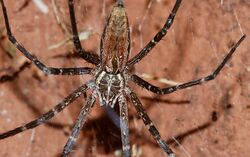Biology:Euprosthenops
From HandWiki
(Redirected from Biology:Euprosthenomma)
Short description: Genus of spiders
| Euprosthenops | |
|---|---|

| |
| Scientific classification | |
| Domain: | Eukaryota |
| Kingdom: | Animalia |
| Phylum: | Arthropoda |
| Subphylum: | Chelicerata |
| Class: | Arachnida |
| Order: | Araneae |
| Infraorder: | Araneomorphae |
| Family: | Pisauridae |
| Genus: | Euprosthenops Pocock, 1897[1] |
| Type species | |
| E. bayaonianus (Brito Capello, 1867)
| |
| Species | |
|
9, see text | |
| Synonyms[1] | |
Euprosthenops is a genus of nursery web spiders that was first described by Reginald Innes Pocock in 1897.[3]
Species
(As of October 2021) it contains ten species and one subspecies, found only in Africa, India and Israel:[1]
- Euprosthenops australis Simon, 1898 – Senegal, Nigeria, Zambia, Botswana, South Africa
- Euprosthenops bayaonianus (Brito Capello, 1867) (type) – West, Central, East Africa
- Euprosthenops benoiti Blandin, 1976 – Rwanda
- Euprosthenops biguttatus Roewer, 1955 – Congo, Namibia
- Euprosthenops ellioti (O. Pickard-Cambridge, 1877) – India
- Euprosthenops insperatus Zonstein & Marusik, 2021 – Israel
- Euprosthenops pavesii Lessert, 1928 – Central, East Africa
- Euprosthenops proximus Lessert, 1916 – Central, East, Southern Africa
- Euprosthenops p. maximus Blandin, 1976 – Ivory Coast
- Euprosthenops schenkeli (Roewer, 1955) – East Africa
- Euprosthenops wuehlischi Roewer, 1955 – Namibia
See also
References
- ↑ 1.0 1.1 1.2 Gen. Euprosthenops Pocock, 1897. Natural History Museum Bern. 2021. doi:10.24436/2. http://www.wsc.nmbe.ch/genus/2402. Retrieved 22 October 2021.
- ↑ Blandin, P. (1974). "Etudes sur les Pisauridae africaines II. Définition du genre Euprosthenops Pocock, 1897 et description du genre Euprosthenopsis n. gen. (Araneae-Pisauridae-Pisaurinae)". Revue Suisse de Zoologie 81: 946.
- ↑ 3.0 3.1 Pocock, R. I. (1897). "Descriptions of two new species of scorpions from East Africa". Annals and Magazine of Natural History 19 (6): 116–119.
Wikidata ☰ Q5408060 entry
 |

